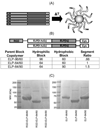Morphing low-affinity ligands into high-avidity nanoparticles by thermally triggered self-assembly of a genetically encoded polymer
- PMID: 20334355
- PMCID: PMC2862343
- DOI: 10.1021/nn901732h
Morphing low-affinity ligands into high-avidity nanoparticles by thermally triggered self-assembly of a genetically encoded polymer
Abstract
Multivalency is the increase in avidity resulting from the simultaneous interaction of multiple ligands with multiple receptors. This phenomenon, seen in antibody-antigen and virus-cell membrane interactions, is useful in designing bioinspired materials for targeted delivery of drugs or imaging agents. While increased avidity offered by multivalent targeting is attractive, it can also promote nonspecific receptor interaction in nontarget tissues, reducing the effectiveness of multivalent targeting. Here, we present a thermal targeting strategy--dynamic affinity modulation (DAM)--using elastin-like polypeptide diblock copolymers (ELP(BC)s) that self-assemble from a low-affinity to high-avidity state by a tunable thermal "switch", thereby restricting activity to the desired site of action. We used an in vitro cell binding assay to investigate the effect of the thermally triggered self-assembly of these ELP(BC)s on their receptor-mediated binding and cellular uptake. The data presented herein show that (1) ligand presentation does not disrupt ELP(BC) self-assembly; (2) both multivalent ligand presentation and upregulated receptor expression are needed for receptor-mediated interaction; (3) increased size of the hydrophobic segment of the block copolymer promotes multivalent interaction with membrane receptors, potentially due to changes in the nanoscale architecture of the micelle; and (4) nanoscale presentation of the ligand is important, as presentation of the ligand by micrometer-sized aggregates of an ELP showed a low level of binding/uptake by receptor-positive cells compared to its presentation on the corona of a micelle. These data validate the concept of thermally triggered DAM and provide rational design parameters for future applications of this technology for targeted drug delivery.
Figures





References
-
- Ehrlich P. Collected Studies on Immunity. 1906
-
- Adams GP, Schier R, McCall AM, Simmons HH, Horak EM, Alpaugh RK, Marks JD, Weiner LM. High Affinity Restricts the Localization and Tumor Penetration of Single-Chain Fv Antibody Molecules. Cancer Res. 2001;(12):4750–4755. - PubMed
-
- Caplan MR, Rosca EV. Targeting Drugs to Combinations of Receptors: A Modeling Analysis of Potential Specificity. Ann Biomed Eng. 2005;(8):1113–1124. - PubMed
-
- Mauriz JL, Gonzalez-Gallego J. Antiangiogenic Drugs: Current Knowledge and New Approaches to Cancer Therapy. J Pharm Sci. 2008;(10):4129–4154. - PubMed
-
- Mammen M, Choi SK, Whitesides GM. Polyvalent Interactions in Biological Systems: Implications for Design and Use of Multivalent Ligands and Inhibitors. Angew Chem Int Ed Engl. 1998;(20):2754–2974. - PubMed
Publication types
MeSH terms
Substances
Grants and funding
LinkOut - more resources
Full Text Sources
Other Literature Sources

